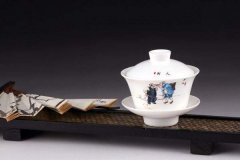The production process of Phoenix Dancong tea and Tieguanyin explain which is better, Lingtou Dancong tea or Phoenix Dancong tea.
Once the tea is picked, there are generally six steps in the production of oolong tea: withering, stirring, killing, kneading, drying and baking. Although the varieties of oolong tea vary from region to region, each step is briefly described here. Withered tea leaves will be left outside withered after indoor withering. At this stage, the cell wall of the tea begins to decompose, and the tea becomes soft and flexible, ready for further processing. This withering can be done outdoors or indoors, but the key is to expose the leaves slightly to the sun. The best conditions for this situation are usually slightly cloudy, the light is softer and the sun is not too dazzling. This stage depends largely on the weather, and farmers and producers must determine the best time to start processing tea. Sometimes in the morning, sometimes in the late afternoon. The tea leaves wither outdoors, however, once they begin to wither, the processing of the tea cannot really stop until it is nearing its end, lest they want to throw it away. This means that if withering begins in the late afternoon, tea producers need to stay up until the wee hours of the morning to ensure the best quality of tea. A key step in stirring dry tea leaves and shaking them in a large bamboo tube to make oolong tea is to shake the tea. Traditionally, after withering, the tea is placed on a large bamboo plate, or put into a large bamboo winder, and then "shake well". The vibration slightly scrapes the leaves, causing them to begin to gently release the tea juice inside them. Then the juice comes into contact with oxygen in the air, and a chemical reaction called "oxidation" begins. The desired degree of oxidation in tea depends on the type of oolong tea and the manufacturer, which will determine how often and how often they shake the tea. Normally, the tea producer shakes every 1.5-2 hours for 5-10 minutes, repeating the whole process 5-6 times. Tea juice will also give off aroma, at this stage, the aroma will also be released into the air. At this stage of tea processing, the smell of the room is incredibly fresh and intoxicating. After a few hours of green removal, once the shaking is completed and the expected oxidation level is reached, the tea will be heated and the oxidation level becomes "fixed". This can be done either in a large frying machine or by hand in a large pot-shaped container. This stage, also known as "killing the green", more or less determines the color of the finished tea. According to the type of oolong tea and the area produced, the next stage is to form the tea, which also means that the leaves go into twisted strips (such as Phoenix Dancong or Wuyi rock tea), twisted and molded into small balls. This is either manual or, in most cases, for modern producers, it is done by machine. At this stage, producers need to be careful and apply the right pressure to get the desired shape, but do not tear or tear the tea. After the loose lump tea is formed, the tea producer needs to loosen the caked tea and put it on a large bamboo tray, ready for drying.

Once the tea is molded into the desired shape and loose, the tea is fired or dried for the first time, usually in large, temperature-controlled, oven-like equipment, which is specially made for tea production. Once the brewing is completed, the tea is now in the "Mao tea" stage, or coarse tea stage. From here on, the producers begin to classify the tea, picking out the stems and any unwanted parts from the tea. This can be classified by machines, but for many small manufacturers, it is still done by hand. After sorting dry tea leaves, tea producers can have a rest, because tea leaves generally maintain their taste and characteristics, while in the stage of maocha. It is at this time that buyers come in and begin to taste all kinds of thatched tea and judge whether they want to buy the tea or not. The Mao tea will show most of the flavors and characteristics of the last kind of tea, but the final baking will bring these out and make the tea more complex. However, for greener oolong tea, the tea goes through two drying stages rather than the last baking. Baked tea the last step in making dark and heavy oolong tea from charcoal in a bamboo basket is to bake or bake maocha for the last time. Baking increases the taste of the tea, making it more complex and mellow, and it can also be better preserved for a long time. The taste can be adjusted according to the baking level, and buyers can require lighter or heavier baking according to their taste preferences. Heavier baking can also be used to cover up errors in previous steps in the tea production process or, in some cases, to mask the bad characteristics of low-quality tea. In most cases, the final baking is done in an oven-like machine that is the same as the drying stage, but the settings need to be adjusted; sometimes, usually in order to obtain higher quality tea, the final baking is done through the charcoal firing process. Charcoal burning is a labor-intensive process that requires several hours of care and monitoring to ensure that the correct calories are used continuously throughout the process. Some minor mistakes, for example, if a small piece of tea accidentally falls into the charcoal, it will produce smoke, which will cover the tea, and once very expensive tea will be over-smoked and become even less valuable now. The process of burning tea with charcoal is usually used only for high-grade tea.
Important Notice :
前街咖啡 FrontStreet Coffee has moved to new addredd:
FrontStreet Coffee Address: 315,Donghua East Road,GuangZhou
Tel:020 38364473
- Prev

Characteristics and differences between Phoenix Dancong, Tieguanyin, Dahongpao Rock Tea and Taiwan Oolong Tea
What is oolong tea? To put it simply, oolong tea is a semi-oxidized tea between green tea and black tea. The oxidation rate of green tea is very low, close to zero, while the leaves of black tea are completely oxidized. The oxidation degree of oolong tea is between green tea and black tea. The oxidation degree of some tea is about 10-20%, while that of some tea is about 10-20%.
- Next

The time parameters of cold soaked duck shit fragrant Phoenix Dancong oolong tea share the story of the origin of duck shit fragrance name
Variety: Dancong Oolong Tea Origin: the area around Chaozhou City, Fenghuang Village, Chaozhou City, Guangdong Province, China is famous for producing Dancong tea. This variety of oolong tea has about 18 different aroma varieties, each of which has its own unique flavor and characteristics.
Related
- Brazilian coffee yellow bourbon brewed flavor characteristics and origin share! What grade is red bourbon coffee?
- How to judge the roasting degree/concentration/filtration method of coffee beans from the color of coffee soup? What is the difference between dark and light roast coffee?
- Why are the coffee in some coffee shops not enough after being frozen? What should I make up for my American latte cappuccino coffee after being frozen?
- How much water does it take to steam coffee by hand? Why is the coffee brewing and steaming time 30 seconds? What is the purpose of steaming coffee?
- The suspected drink contains too much caffeine! Overlord Tea Lady responds urgently!
- Starbucks rejects antique paper coupons?! Netizen: Missed marketing opportunities!
- What ratio of water temperature and ground does the smart cup method use to press coffee? The difference between brewed coffee and filtered coffee?
- What is the standard process for the purpose of coffee cup testing? What is the difference between hand-brewed coffee and cup testing?
- How to use hand-brewed coffee paragon small golden balls? How does cold coffee lock in the aroma of coffee?
- Is American coffee black? What is the difference between American coffee and drip coffee?

